
38 minute read
29 Navigating covid-19’s challenges
FamilyMedicine
For Dalhousie’s Dr. Alyson Kelvin and her father Dr. David Kelvin, a passion for understanding, treating and preventing pandemics has put them at the forefront of international research on covid-19 vaccines and bio-markers. By Ryan McNutt
Advertisement
On the night of December 30, 2019, Alyson Kelvin was at home in Halifax, on the other side of the world from Wuhan, China. She was just about to put down her book, shut out the light and bring a fulfilling day of Christmas vacation to an end.
Until she checked her email one last time and found an alert from the ProMED infectious disease listserv detailing a mysterious new disease outbreak. “201912-30, 23:59:000. Re: Undiagnosed pneumonia—Chine (HU): Request for Information. Some medical institutions in Wuhan have successively appeared patients with pneumonia of unknown cause…” Suddenly, sleep moved far down her priority list.
“I’m not an alarmist, so I didn’t jump on it and wave my arms like, ‘The next deadly pandemic is coming,’” she says, thinking back to her first read of that email alert. “But I knew we had to be working on this. Pneumonia, something hitting our respiratory track, is very concerning—that’s how we breathe, and also how viruses are easily spread,” she says.
There was also the high number of patients; the report indicated at least 27 were known at the time. “That suggested either everyone who was being infected had to be hospitalized—so the virus was very severe—or that what we were seeing, more like a flu, is that the hospitalizations really indicate the severe cases, the tip of the iceberg.”
In the days ahead, Dr. Kelvin, an assistant professor in Dalhousie’s Faculty of Medicine, would be communicating regularly with colleagues at vido, a world-leading vaccine centre located in Saskatoon, Saskatchewan. Less than two months later, she would upend her entire life to travel there and work hands-on with the virus that would eventually be known as covid-19—the coronavirus that would spark the largest global pandemic in a century.
But that night, Dr. Kelvin’s first outreach wasn’t to vido. It was to a Dal colleague, one who has been there for her as a collaborator and confidant her entire career—and then some.
She called her father, David.
a pandemic spans borders. Those researchers tasked with addressing its many challenges must do the same—working across jurisdictions, across disciplines and, in the case of the doctors Kelvin, across generations.
David, a professor in the Department of Microbiology and Immunology, has been a key figure in emerging infectious disease research for decades. His work is international in scope, carrying out studies with home bases in China, Italy and Canada.
“My interest in diseases evolved out of hiv,” he says. “hiv is what I’d call a slow pandemic: it wasn’t something that spread in a matter of weeks, it took years and it really affected everybody in my generation
“My work evolved out of trying to understand why some people got serious illness and others did not. ” —Dr. David Kelvin
who was going through our early 20s at that point… My work evolved out of trying to understand the molecular mechanisms of infectious diseases and, in regard to pandemics and epidemics, why some people got serious illness and other people did not.”
You can trace David’s career through several major infectious disease outbreaks over the past 30 years, but the 2003 sars epidemic stands out as a major flashpoint. He was a researcher in Toronto when sars began moving through the health-care system there. So, too, was Alyson: having just completed her undergraduate degree at Western University, she was doing a summer internship at a local hospital. Her work involved screening health-care workers for symptoms while also working with sars patient samples.
“I was seeing sars on two levels: both how to socially contain an emerging virus or a virus now spreading through a community, and also working on the science of what’s actually happening in molecular medicine,” she says. “I think that was really influential to me in how I viewed public health and research goals.”
It was never a given that Alyson would follow her father’s path into disease research; for a while she wanted to be a surgeon, or an astrophysicist. But both father and daughter recall vividly that Alyson had an innate childhood curiosity with everything David was doing in the lab, which she would often visit as a toddler. “She was fascinated by infectious disease as far back as I can remember,” says David.
“I recall being really interested in all the discussion around HIV at the time as well,” says Alyson. “That’s what gave me this vision of working in an isolation room with highly pathogenic viruses.”
Following a PhD that was more focused on molecular science, Alyson returned to diseases, studying an outbreak in Italy of a mosquito-borne virus called chikungunya that had recently migrated to continental Europe from Africa. Shortly after—and
not for the last time in her career—a pandemic intervened: the 2009 h1n1 swine flu pandemic, which immediately became her new research focus. The experience was both professional and personal for Alyson.
“I was four months pregnant, researching viruses with the threat of a new pandemic that had a second wave anticipated to happen right when my daughter was due,” she recalls. “I was very much a vulnerable population. So trying to understand age and developmental processes and how that was a risk factor [for diseases] became not only a research priority, but a piece of my life.”
Alyson and David’s respective careers continued separately, each in their own fields, but always linked through the family connection—sharing notes, ideas and insights whenever they caught up with one another.
Which brings us back to that phone call last December.
“i think i told her to go back to bed,” David Kelvin recalls with a hearty laugh.
It was the time of day, more so than the news itself, that inspired David’s initial reaction to Alyson’s phone call. He knew the unknown outbreak in China was something to watch but admits he wasn’t sure, at first glance, just how wary he should be.
“It was really over the next two or three days that the cases dramatically increased and [Alyson and I] had several discussions about it,” he says. “It started to have all the hallmarks of human-to-human transmission.”
In the weeks to come, David would begin an international research collaboration trying to identify biomarkers for patients infected with the new coronavirus. A biomarker is any sort of biological “tell” that helps a patient or health-care professional determine how and when to apply a particular therapeutic—for example, how glucose levels help a diabetes patient decide when to apply insulin. With
Dr. David Kelvin has been a key figure in emerging infectious disease research for decades.
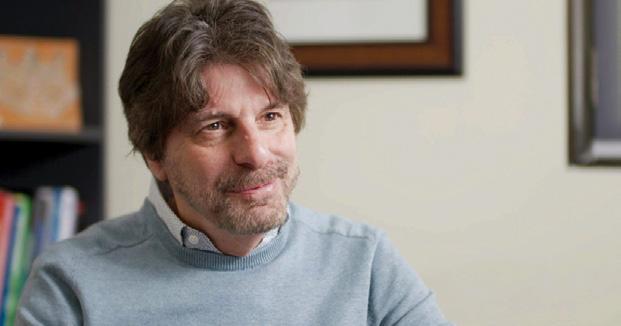
covid-19, the idea is to find biomarkers that can help sort out which patients are at risk of more serious infections and, therefore, more likely to require intensive medical care.
“Many people who go on to have severe illness from covid-19 don’t have severe symptoms in the early stages—those don’t develop until about the end of the first week of illness. What we’re really trying to do is develop methods to test individuals at the earliest stages and identify which of them would go on to have a severe illness, and where those specific biomarkers would tell us how best to treat them.”
David began by assembling a research team from 15 different countries—even more are involved now—some of which ended up being among the regions most affected by the outbreak’s first wave, including Spain and Italy. Collaborating with local health-care systems, his team gained access to thousands of blood samples and medical files. The aim is to identify two or three simple tests that will help front-line health-care professionals assess which patients are most likely to become serious cases—not only saving lives, but also conserving essential resources for those who need them most.
“If an area sees a large outbreak of
“We all have a vested interest in developing a vaccine that is going to be effective and safe.” —Dr. Alyson Kelvin
cases—like in Spain, or Italy, or this summer in Texas—we see that icu beds are in very limited supply just because of the sheer number of people infected with covid-19. This will help identify people who are likely to develop a severe illness and give those people the highest priority for icu beds.”
an explosion of cases that leads to icu beds filled with sick and dying patients is among the worst possible outcomes in a pandemic like covid-19. The best possible outcome is that a widely available vaccine, or group of vaccines, successfully limits the spread of the virus, allowing people to resume more of their usual way of life.
Alyson Kelvin is one of many researchers around the world working to develop and test covid-19 vaccines. Her research model uses ferrets to understand how potential vaccines work in different types of patients: in older individuals, in pregnant women, in children and toddlers.
“Vaccination is different in all these age groups,” she explains. “And we know with covid-19 that there’s a higher mortality rate for people in older age groups. If we can understand why we have those high rates of death, it will be incredibly important to developing specific therapeutics for that age group.”
Through January and February, Alyson began collaborating with colleagues at vido in Saskatoon who were working to acquire physical samples of the virus to start conducting studies. Despite running one of the highest-security labs at Dalhousie, Alyson knew vido’s clearance level was higher. Leaving her colleagues and family behind in Halifax wouldn’t be easy—“I knew then that, a month from now, our lives were not going to be the same, and I was going to be out here [in Saskatchewan]”—but it quickly became her best opportunity to acquire and work quickly with the virus. The first covid-19 samples in Canada, from the country’s first patient in Toronto, arrived just as the paperwork came together.
Being hands-on with the covid-19 virus in the lab has significant advantages, and not just for Alyson directly. It’s allowed her to support other researchers at Dalhousie, like vaccine work by Dr. Roy Duncan, Dr. Marianne Stanford and Dr. Chris Richardson or anti-virals being developed by Dr. Craig McCormick. And she’s been able to help coordinate the varied and diverse international vaccine research currently underway as part of the advisory group on pre-clinical animal model development and vaccine evaluation for the World Health Organization.
“We all have a vested interest in developing a vaccine that is going to be effective, safe and able to provide protection to a great number of people—but this isn’t going to happen with just one vaccine,” says Alyson. “We need multiple options for several reasons: we have different vulnerable groups, different groups that are going to be more receptive to a vaccine over another, and just capacity for making these vaccines will be so different all around the world.”
as the summer heat turns to autumn chill, the fear among epidemiologists is that the coronavirus won’t necessarily cool down—that a second wave of cases may begin moving through regions that have seen lower infection rates through the summer. At the same time, experience in other countries where cases continue to rise suggest that, one way or another, covid-19 will continue to be
part of our lives in a significant way in the months and, possibly, years to come—even with vaccines.
Alyson is optimistic about the likelihood of a widely available vaccine in 2021, but even a vaccine with strong efficacy rates will leave some populations vulnerable to the disease. Additional supporting measures, like antivirals and other therapeutics, will be necessary, as will continued public health guidelines to protect one another from infection while further effort on vaccine and therapeutic refinement continues.
“We all have to work together,” says David, speaking with concern about countries that have taken a more casual or cavalier attitude towards the virus. “Whether it’s for the next pandemic or just in the coming months, we have to do a better job of convincing the entire public to get on the same page when it comes to following basic public health measures. Because if we’re not, we’ll have a global community where the virus continues to move around.”
That’s one of the many subjects that Alyson and David talk about in their regular check-in conversations. Alyson is used to being the one having to track David down somewhere in the world for these, but this summer the roles were reversed: David was at home in Halifax and Alyson was away in Saskatoon. (She’ll be there for the next year; her family joined her in August.)
For David, part of what’s been particularly inspiring about Alyson’s work through the pandemic’s first months is not just her prominent role with respect to global covid-19 vaccine development but her public engagement as well.
“She’s not only driving important research forward but she’s out there in the media trying to bring these complex problems to the public and communicate things clearly,” he says. “We need people out there taking that leadership role.”
“We do very different work,” says Alyson, “but at the end of the day it’s great to have somebody like that to bounce ideas off of.”
Research across the university
The challenge of the pandemic has inspired urgent, new research across the Dal community—and not just in vaccines either. With support from the federal government as well as the Nova Scotia covid-19 Health Research Coalition, projects are underway to understand the impacts of covid-19 and also provide knowledge and best practices for potential future pandemics.
senaTor dr. wanda Thomas bernard and dr. nancY ross (Social Work) are assessing how impact of covid-19 can inform social policy and health care to better respond to gender-based violence in African Nova Scotian communities. dr. John FramPTon (Biomedical Engineering) is working with nscad University Professor garY markLe on a prototype textile for locally manufactured personal protective equipment. drs. graham gagnon and amina sToddarT (Civil and Resource Engineering) are studying whether uv light can be used as a disinfectant to allow safe re-use of n95 masks. dr. scoTT haLPerin (Pediatrics/Microbiology and Immunology) is bringing together a global team to understand the effects of public health outbreak control policies and implementation on individuals and communities. dr. roberT huish (International Development Studies) is examining the consequences of cultural stigma from covid-19 ordinances in Nova Scotia, New Zealand and Australia. dr. margoT LaTimer (Nursing) is identifying occurrence rates and complicating factors for Mi’kmaq community members in Nova Scotia diagnosed with covid-19. dr. Jeanna Parsons Leigh (Health Administration) is working with clinicians, researchers and the public across Canada to gauge people’s perceptions of covid-19 and combat misinformation, stigma and fear. dr. caTherine mah (Health Administration) is leading investigations into the nutritional consequences of how Atlantic Canadians eat during the covid-19 pandemic. dr. emiLY marshaLL (Family Medicine/Psychiatry) is exploring pandemic-related challenges in access to primary health care. drs. sandra meier (Psychiatry) and riTa orJi (Computer Science) have teamed up for a study that uses smartphones to monitor the impacts of social distancing and isolation on youth. dr. rudoLF uher (Psychiatry) is examining the impact of the covid-19 pandemic on Canadians living with mental illness, as well as their families. dr. ingrid waLdron (Nursing) is working to develop a culturally specific covid-19 response strategy to improve access to covid-19 testing and health services and reduce infections among African Nova Scotians living in the Prestons.
Navigating covid-19’s challenges
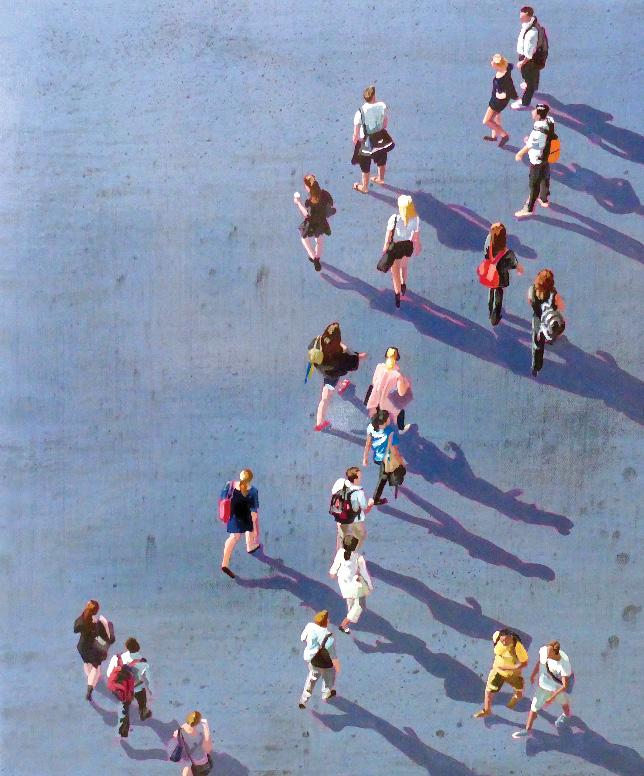
the covid-19 pandemic stopped us in our tracks. But inaction wasn’t an option. We have to find ways forward and “new normals”—to stop doing some things, change how we do others but ultimately to do our best to address the myriad challenges we face. Every sphere of human activity has been affected. At Dal, our new normal has pushed us to innovate in teaching, lab work and connecting as a community. It’s meant refocusing research efforts to solve pandemic-related problems. And it’s meant drawing on the best of ourselves as leaders, community members and thinkers. In the pages that follow, we explore the many ways that the Dalhousie community is navigating covid’s ongoing challenges. By Matt Reeder with files from Dalhousie’s Communications team
the 2020-21 academic year will be unlike any in Dalhousie’s history. A majority of our courses will be online. Most faculty and staff continue to work remotely, while those who have returned to campus are following new guidelines to ensure the health and safety of our entire community. As we gradually re-open campus spaces and labs, many front-line services and supports will look a bit different, such as our libraries and fitness facilities.
What has not changed through all of this is Dalhousie’s commitment to our mission—to supporting student success, to advancing world-leading research, and to improving the way of life in our communities. If anything, the covid-19 pandemic has illuminated just how successful our university can be when it comes together in new ways to tackle great challenges.
The stories ahead are just a small glimpse into how our Dal community has met extraordinary circumstances with extraordinary efforts over the past several months. Even at a safe social distance, we remain united as One Dal—bringing our diverse talents together to make a real difference when it matters most.
Deep Saini President and Vice-Chancellor
Solving Prob lems
Lessons in safety: Keeping patients’ airways open became an immediate concern in the pandemic, as intubation—the routine procedure for keeping patients oxygenated and threading breathing tubes into their airways—became fraught with danger for clinicians who could be contaminated by the covid-19 virus during the procedure. Dal experts quickly developed provincial airway management guidelines and began supporting hospital emergency departments in training for and adapting to the new standards. Dalhousie’s Human Body Donation Program was able to assist as teams began training on the new procedures by working with cadavers. Said Dr. George Kovacs, a professor in the departments of Emergency Medicine and Medical Neuroscience and a national leader in airway management training, “guidelines were being generated and practice changed in a matter of weeks. We ramped this up fast. It was amazing. The silos went down and people adopted a can-do collaborative attitude; we worked every waking hour.”
Retired horticultural professor and Raging Crow Distillery co-owner Kris Pruski shifted his business’s focus to produce hand sanitizer.

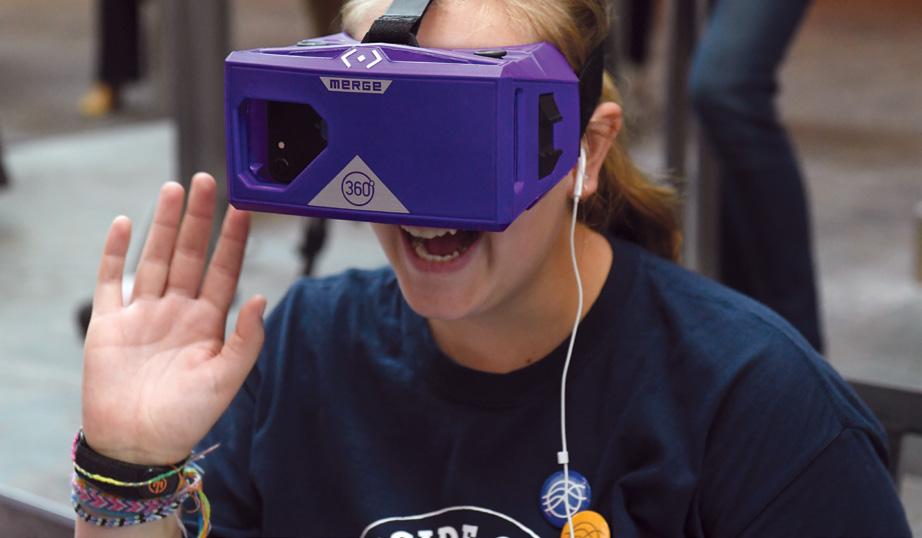
Ocean School, a free bilingual platform founded by Dal, the National Film Board of Canada and Ingenium, offers immersive film, virtual reality, 360 video, interactive games and augmented reality content related to ocean research.
Distilling a solution: Retired horticultural professor and Raging Crow Distillery co-owner Kris Pruski in Truro shifted his business’s focus this spring to produce in excess of 2,000 litres of hand sanitizer, some of which was donated to fire departments, Truro Police Services and the von.
Making it easier to share health-care wishes: Canada’s first personal directive app, developed by Dalhousie Schulich School of Law Professor Jocelyn Downie and the Legal Information Society of Nova Scotia (lisns), garnered increased attention in the pandemic for its ability to help Nova Scotians more easily create and share a personal directive document that sets out key decisions around health care. The website-based app can be accessed at legalinfo.org/forms/personal-directive. Fast face shields: In just a week, an interdisciplinary team from the Faculty of Engineering, working with colleagues at the Nova Scotia Health Authority, was able to design and prototype a 3d-printed face shield that was simple and easily scalable from 3d manufacturing to injection molding capable of producing thousands of units. “We’ve been able to go from just an idea to something that actually we could produce hundreds of thousands of if we needed to,” said Clifton Johnston, an associate professor in the Department of Mechanical Engineering who is leading the project.
Home school resources: Parents looking for resources to help support their children’s at-home learning were able to get help from some Dal-affiliated groups. SuperNOVA, a not-for-profit that promotes science, engineering, technology and mathematics to young people, launched an at-home learning series and used Instagram, Facebook, Twitter and YouTube to facilitate quizzes and experiments. Ocean School, a free bilingual platform founded by Dal, the National Film Board of Canada and Ingenium, offered immersive film, virtual reality, 360 video, interactive games and augmented reality content related to ocean research, aimed at students in grades six to nine. Imohotep’s Legacy Academy posted videos and hosted virtual meetups for African Nova Scotian youth, and Dal’s Sciographies science podcast featured interviews with researchers about science careers.
Dr. Bonnie Henry speaking to reporters in British Columbia.
in good hands
For many Canadians, calm during covid-19 was aided by confidence in the provincial public health leaders, four of whom are Dal alumni. Dean of the Faculty of Health Dr. Brenda Merritt offers her thoughts on what we can learn from their examples.

i have been thinking a lot about leadership lately, and what is needed to guide others effectively during a crisis of the magnitude of covid-19, when lives and livelihoods are at stake.
Leadership is about establishing trust, genuinely listening to the needs of your community and responding in a transparent and proactive way. This is especially tough in a situation that’s constantly changing. Acknowledging that you don’t know all the answers is ok. Acknowledging that it’s hard is ok. As leaders, we are also human.
Watching our public health leaders over the past months— and especially our Dal alumni Dr. Bonnie Henry in b.c., Dr. Jennifer Russell in n.b., Dr. Heather Morrison in p.e.i. and Dr. Janice Fitzgerald in Newfoundland and Labrador— we see that transparency, that trust. Sure, we may have loved Dr. Henry’s shoes—but we valued her honesty and empathy more. And while t-shirts portrayed Dr. Morrison as a superhero, it was her grounded, calm clarity that gained Islanders’ trust.
They’ve taught us that it’s critical to clearly and openly communicate. If you don’t know something, collaborate with others to find a solution or answer. It is unrealistic to set an expectation with yourself and others that you know all of the answers during a global crisis that not one of us have ever encountered. This approach can serve to build trust while pulling together the collective wisdom to move forward together.
What concerns me now is that people are very tired from worry, decision fatigue and balancing family life with the changes in their work. Dr. Fitzgerald reassured us that it’s normal to be worried. Dr. Russell reminded us that we need to connect with our loved ones, eat properly, exercise and take deep breaths. We need to take time to rest and take care of ourselves and each other. These leaders— great leaders all—know we have to ensure that mental as well as physical health is protected as we slowly return to our ‘new normal.’
during the covid-19
pandemic public health responses in four of Canada’s 10 provinces have been led by Dal alumni whose guidance has helped limit the spread of the virus and save lives. Here’s a sampling of how they’ve led and what they’ve learned through the experience.
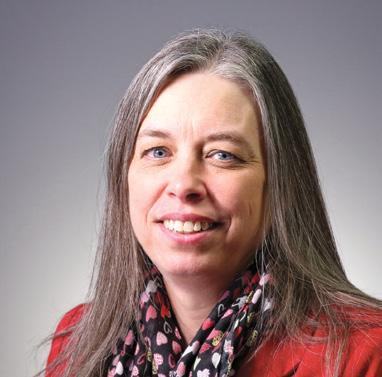
abouT A former regional medical officer, Dr. Fitzgerald recently had “interim” dropped from her title as chief medical officer of health and, despite keeping a low profile, the postgraduate medicine alum has won raves for her steady leadership.
on seeing resuLTs “This is the paradox of public health,” said Dr. Fitzgerald during her May 19 press briefing. “When we are doing things right, it seems as though nothing is happening, and people are getting frustrated wondering why we must still adhere to the measures in place, when in actual fact the reason we are not seeing any new cases is because of these very measures. If they weren’t in place, covid-19 would look very different in our province.”
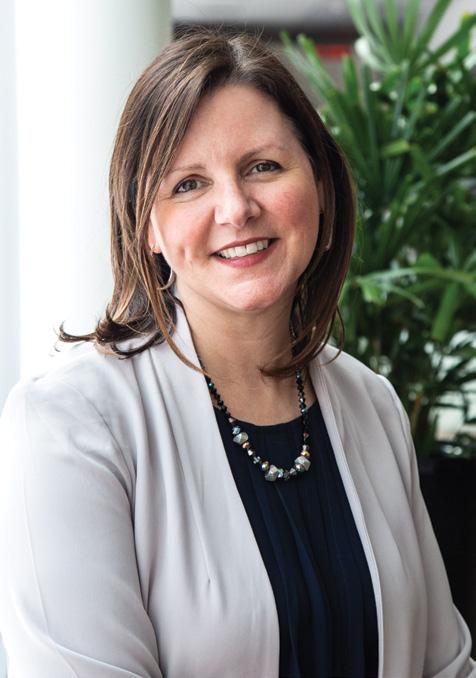
Dr. Jennifer Russell (ba’92, pgm’01) New Brunswick
abouT An alumnus of both Dal’s Faculty of Arts and Social Sciences and the Family Medicine residency program, she’s a former medical officer in the Canadian Armed Forces and New Brunswick’s chief medical officer of health since 2018.
whY credibiLiTY maTTers “Throughout any pandemic we are often learning new and emerging information in real time. With ever-changing information and emerging data, this can be difficult to communicate to the public and ensure they have the information they need… that is why it is so important to ensure any and all information you are gathering on the situation is from reliable and creditable sources.”
on Teamwork “A leader is not a leader without their team. This is something I have always believed to be true but has certainly been more apparent throughout these past few months. The amount of collaboration, support, long hours and dedication that I have seen not only in public health but across all sectors has been incredible.”

Dr. Heather Morrison (md’99) Prince Edward Island
abouT p.e.i.’s chief health officer since 2007, Dr. Morrison is a Dalhousie md graduate and former Rhodes Scholar who continues to practise emergency medicine in Charlottetown.
on communicaTion “The ongoing challenge is how we communicate in a calm, authentic way about something that’s new to everyone, that has evolving evidence and where there’s so much underlying fear and anxiety… and will continue to be one as we go through a potential second wave right through to a vaccine.”
on care and comPassion “I finish a lot of my press conferences by saying, ‘Be safe and look after each other—let us be patient and let us be kind.’ When I’m saying them to the public as we go through this journey together, I’m saying them to myself as well… It’s about trying to be patient, be safe and be kind to yourself as well as to others.”
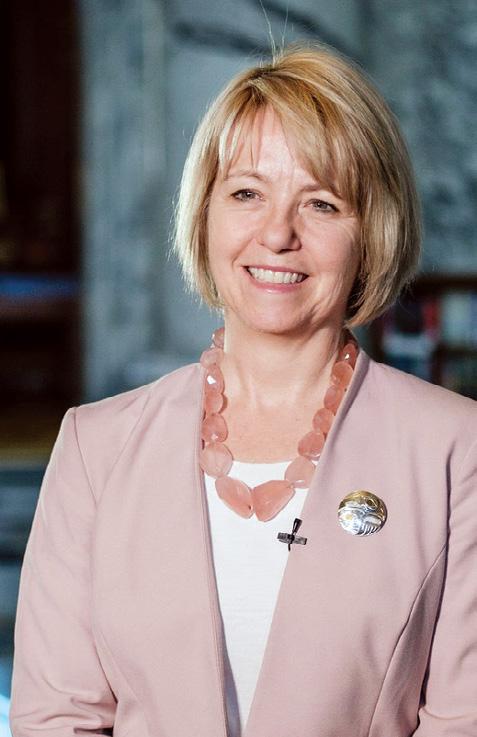
Dr. Bonnie Henry (md’90) British Columbia
abouT Originally from Charlottetown, p.e.i. she’s a Dalhousie Medical School grad who served as operational lead for the 2003 sars outbreak in Toronto and has been b.c.’s provincial health officer since 2018.
PreParing The PubLic “Getting everyone in the health sector and then across government and all communities in b.c. to understand what might happen and what we needed to do to prepare and then to respond was the next biggest challenge. But I believe that if we give people the information about what they need to do, why we need them to do it and the means to do it, then most people will do just that.”
The imPorTance oF kindness “I have said, ‘We are all in the same storm but we are not all in the same boat’—having compassion and supporting each other is what will get us through. My mantra to be kind, be calm and be safe reflects that. We need to be kind to each other and to ourselves; take a deep breath and be calm as we do not always know the full story of why someone else is doing what they are doing; and be safe by doing the things we know work to protect ourselves, our families and our communities.”
Stepping
Forward
(top) Instructors and students in Dal’s Costume Studies program stitched masks for use at the university’s health services. (bottoM) Tanas Sylliboy, rn and graduating Master of Nursing student, created community education materials and care packages for people self-isolating in his community of Eskasoni.
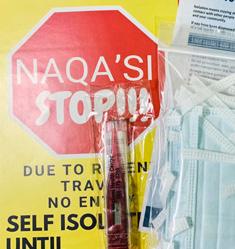
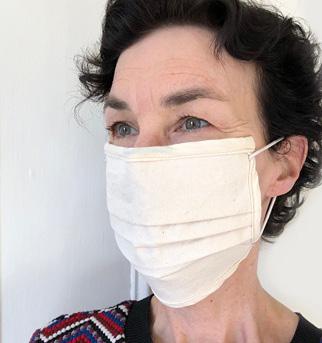
Caring for his community: Athanasius “Tanas” Sylliboy, rn and graduating Master of Nursing – nurse practitioner student, worked hard in his community of Eskasoni to minimize the impact of covid-19, including creating community education materials and care packages for people self-isolating, doing wellness checks and check-ins. “I wanted to minimize the impact of covid-19 through education and resources. It’s not even doing work or volunteering, it’s my responsibility to do what I can to help.”
Dental emergencies: When dental offices across the province were closed down due to the pandemic, Dal’s emergency dental clinic remained open—and took the lead in developing safe practices and protocols for treating patients during the covid-19 pandemic. These protocols were shared with dental schools and professional dental bodies across the country, and used to train dentists to meet the requirements, allowing five additional emergency dental clinics to open around the province.
Business solutions: For co-op students, the covid-19 spring lockdown meant an end to many placements. But thanks to outreach from the Government of Nova Scotia, some Dal commerce students had a new opportunity: helping to evaluate the province’s Small Business Impact grant, which offered a up to $5,000 to small businesses impacted by the pandemic. Students had to apply for the positions and approximately 20 were hired, mostly from the Commerce program, but also from the mba program. “I feel really proud of the fact that we were able to get money into the hands of these small businesses in a timely manner,” says Tammy Crowell, a senior instructor in the Rowe School of Business who hired, trained and supervised the students along with senior instructor Laura Cummings and associate professor Louis Beaubien. “I’m sure for some of them it made the difference in continuing to operate.”
Students and alumni step up: From drives to gather personal protective equipment (ppe) and organizing childcare for health-care workers, to developing web apps to match volunteers with those in need, Dalhousie students and alumni stepped up in a big way. ppe has been donated and distributed, almost 100 Dal medical and health students volunteered to provide childcare for health-care professionals, and JeyaBalaji Samuthiravelu (macs’17) and Srisaichand Singamaneni (macs’19) created the “care mongering” web app care-mongering.ca to link people in need with those in the community able to volunteer. Instructors and students in Dal’s Costume Studies program stitched masks for use at the university’s health services, Nursing students Sydney Miller and Sarah Keeping volunteered with Nova Scotia’s 811 service, and many other Dalhousie community members donated time and effort for covid-related programs.
Research Opportunities

Prior to covid-19, Dr. Jong Sung Kim’s toxicology lab in the Tupper Medical Building at Dalhousie was often buzzing with activity at different times throughout the day. Sometimes there’d be as many as 10 students and staff in the space at a time, carrying out a range of complex scientific work from injecting nanoparticles into human cells to analyzing blood samples.
Enter Dr. Kim’s facility now, though, and you’ll encounter a far quieter environment. This shift in climate doesn’t mean there’s less work going on, just that it’s being done in different ways. Students now work on a rotation, with a maximum of six allowed in the space at any one time. Masks are required when six meters distance can’t be maintained. And activities that used to be done in person in the lab, such as equipment training and logging lab results, are now often done virtually through online platforms.
The transformation of Dr. Kim’s lab began back in March when the university asked for the shutdown of all in-person research facilities, except for those doing work related to covid-19. Like other Principal Investigators (pi) and their research teams across the university, Dr. Kim and his students wound down operations. But that didn’t last for long, as two weeks later they were approached by the Nova Scotia Health Authority and Dal to support testing the effectiveness of new types of n95 respirator masks that could help reduce Canada’s reliance on foreign suppliers.
Dr. Kim’s lab isn’t the only one at Dal that’s transitioned its focus to covid-19. Industrial engineering researcher Peter Vanberkel’s health-care operations lab also pivoted quickly, tackling high-priority problems such as the distribution of personal protective equipment (ppe) in Nova Scotia, the return of elective surgical capacity in hospitals, and researching alternatives to n95 respirators.
“For students, they are working on really cutting-edge problems and working with teams that are highly motivated to address these problems,” says Dr. Vanberkel. “From that perspective, it’s
(top) In a simulation course, nursing students wear masks and gloves to protect themselves and each other from COVID-19. (bottoM left) Dr. Jong Sung Kim (bottoM right) Dr. Peter Vanberkel
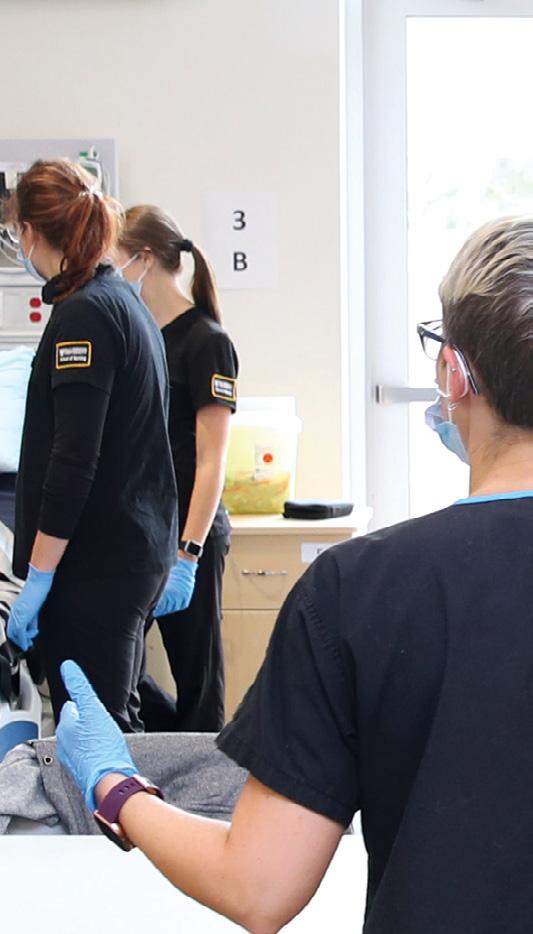
a bit different. Research can have a slow pace, but with the pressures of covid-19, we don’t have that luxury of a slow pace anymore.”
The primary change for Dr. Vanberkel’s students has been the shift from in-person observational work at hospitals to remote consultation. “Students usually have office time in the hospital a few times a week so they can see and observe and understand how things work. That piece went away. It meant doing business a bit differently. It meant we had to rely a bit more on being told what was happening instead of getting to observe it ourselves.”
Other labs across Dal, while not researching covid-19 specifically, have had to adapt their protocols and best practices as well, ensuring that students can continue to build their research careers but in a way that’s as safe as possible.
lab coats and goggles not required
this fall, most students
in programs with lab requirements have seen those activities move to a virtual environment. Learning objectives have been modified to suit the new online programming, with resources enabling high-quality and comprehensive learning experiences for all. In first-year Chemistry, for instance, students get the feeling of being immersed in the lab through virtual 360 lab tours, where students learn the safety protocols they will need for future in-person courses. Students also take part in virtual, interactive experiments that enable them to make real-time observations, with an added emphasis on experimental theory, observation and data interpretation—skills transferable to all science and engineering fields.
“Lab modules are custom built, media rich, interactive, and accessible, with consideration given to clarity in colour schemes, font sizes and slide design as well as fully closed-captioned with downloadable audio transcripts,” says Jennifer MacDonald, senior instructor and firstyear lab coordinator in the department.
Field trips have also gone virtual for some this fall. Mobilizing swiftly this past summer, Michael Young, a senior instructor and undergraduate advisor in the Department of Earth and Environmental Sciences, used drones, cameras and other gear to build 3D models of more than 20 field sites that include kilometre-long stretches of coastal cliff sections, tidal flats and rocky outcrops in hard to reach places. Ultra-high resolution zoomable gigapixel panoramas, videos of course instructors explaining fieldsite features, and more have created quality online learning experiences with added cool factor. “I want students to be able to interact with high-quality visualizations without the frustrations of low-resolution images or poor quality audio,” says Young.
First-year Chemistry students take part in virtual, interactive experiments that enable them to make real-time observations.

lessons from a pandemic past

This past winter was not the first time Dalhousie has had to halt in-person classes due to a global pandemic—and, more than a century ago, there certainly wasn’t any online learning to turn to. By Ryan McNutt
the so-called “spanish
flu” arrived in Nova Scotia in the fall of 1918, carried by soldiers returning from World War I. Dal classes were shut down entirely for five weeks in September on orders of the Halifax Health Board as a measure to contain the spread. It took the province’s fledgling health infrastructure a few weeks to gear up in response to the pandemic, and an estimated 2,200 Nova Scotian lives were tragically lost (more than in the 1917 Halifax explosion), but efforts like isolation orders and shutting down of public spaces made a big difference: Nova Scotia’s death rate from the virus was among the lowest in North America. Credit a health-care system that took smart advice from other jurisdictions (Boston, in particular) and from leadership that included Halifax mayor Arthur C. Hawkins—himself a medical physician.

If you’re wondering what the aftermath of our current pandemic may look like, the 1918 pandemic offers a hopeful precedent. The decade that followed marked a bold new era in the advancement in public health, beginning with the creation of both the federal and Nova Scotia departments of health in 1919 and continuing locally with investments at Dalhousie for a new Infectious Disease Hospital and Tuberculosis Hospital as well as the construction and opening of the Dalhousie Public Health Clinic (now the Clinical Research Centre on University Avenue). And successful public health measures from the time became the foundation on which efforts to address viral outbreaks were built—from h1n1 and sars through to covid-19 today.
(top) Victoria General Hospital in 1918, at the height of the Spanish Flu pandemic. (bottoM) A clipping from The Dalhousie Gazette from the same period, commenting on the interruption to studies caused by the pandemic.
Possibilities in Performance

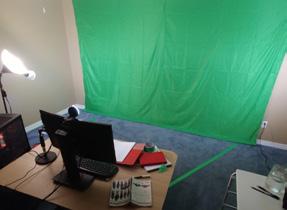
ather than centering on what R can’t be done in light of the shift to online learning this fall, Jacqueline Warwick and her colleagues in Dal’s Fountain School of Performing Arts are choosing instead to flip the narrative. “We are finding the things that we can do now that we couldn’t or wouldn’t necessarily do before,” says Dr. Warwick, the school’s director. “How can we make this really remarkable?”
One way is by reimagining how students train and prepare for live performances, a central aspect of the learning process in the performing arts. In a typical year, the Fountain School produces four plays, an opera, roughly a dozen major concerts and dozens of smaller chamber performances— all featuring student performers. And while that production frequency will be scaled back this year, those performances that do go ahead will offer unique new learning experiences for students.
For instance, for its first theatrical production of the year, the Fountain School will be undertaking a virtual reimagining of Concord Floral, a 2016 Canadian play based on an Italian Renaissance classic The Decameron about a group of people surviving the plague. Although chosen before the
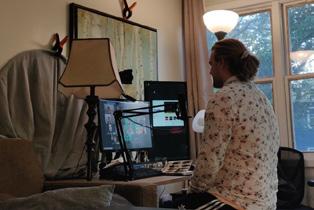
onset of the current pandemic and originally envisioned for the stage, sound and set design and costume work will now be carried out remotely with students using tablets and phones to interact with each other during the performance. Dr. Warwick says audiences can expect a “meaningful and moving” production, which will now be livestreamed for audiences. “When the mold breaks, it’s terrifying. But then we get to make up new ways of being and make new strategies and plans,” she says.
Students can also expect exciting new learning opportunities through even more compelling master classes this fall. A regular component of the Fountain School curriculum (thanks to funding from the Fountain family), Dr. Warwick says holding the sessions virtually now expands the school’s ability to bring in people from performance hot spots such as Los Angeles and London.
In Dr. Warwick’s view, artists will be crucial in the months and years ahead. “This is an opportunity like no other to figure out, ‘How are we going to get through this?’ And I really do think artists are going to lead the way and our students are going to help us learn how to live in this new world that we suddenly find ourselves in.”
left to right: Emma James in her at-home rehearsal space; Fountain School of Performing Arts student Aquila Wibisono’s rehearsal space; Christian Ludwig Hansen works in his rehearsal space; Dr. Jacqueline Warwick says “Our students are going to help us learn how to live in this new world that we find ourselves in.”
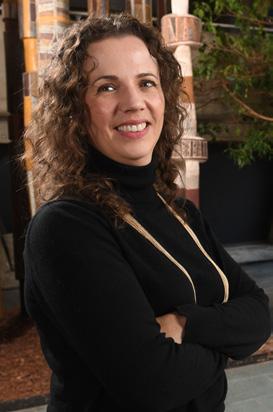
Celebrating Connecting & all become part of 2020’s approach to celrate the fight for our rights, the fight that Ramadan Iftar goes virtual: In May, the Dalhousie community and family and friends around the world joined together for a virtual Ramadan Iftar, the fast-breaking meal after sunset at the end of Ramadan. A joint effort between Dal Connects, Residence, the Muslim Students’ Association, Dal Security, Human Rights & Equity Services and the International Centre, the event’s orgaCelebrating graduates: Virtual celebra- sure Muslim community members—both tions, video messages, platforms to share on and off campus—felt supported and congratulatory messages and more have celebrated this year. ebrating graduations. Among Dal’s special Don’t stop the music: Two recent grads events: a music video recording of Heave from Dal’s Fountain School of Performing Away, created and performed by Dalhousie Arts, Andrew Coll (bm’16) and Neven alumni, faculty and staff, and a virtual Prostran (ma’17), helped take the Scotia Barley Party for the Agricultural Campus, Festival of Music, a two-week chamber where students celebrated receiving their music festival, online under the moniker Barley Rings, a symbol of graduation from “Scotial Distancing 2020.” Both work for the Faculty of Agriculture. the festival and coordinated the producPride & perseverance: When Pride arrived When they reviewed archival footage, they in Nova Scotia in July, covid-19 precau- quickly realized they could supplement tions required a different approach to a live performances and have enough matetime of celebration, with most Dalhousie rial for 14 nights of content. The events Pride activities shifted online. “It’s were so successful that Scotia Festival of really important to remember how Pride Music is working on equipping The Music started,” said Trulee Love, president of the Room venue with permanent live streamlgbtq2sia+ student society DalOUT at ing gear so that they can be a resource in the Instagram livestreamed kick-off event the future for the broader arts community on Studley Campus. “It is to commemo- to broadcast performances to the world. nizing committee took great care to make tion of the livestreamed performances. Food delivery during Ramadan made possible, safely, thanks to the work of we still have to continue, and the fight for communities that may not be our own.” Dal Security, Dal Safe Ambassadors and A flag raising event was also held on the members of Dal’s Residence team. Agricultural Campus.

The pandemic has meant a shift to remote teaching and learning for many courses, a shift that could make Dalhousie programs and courses accessible to more students than in the past.

How can we best prime students for life as business professionals? That’s the underlying objective in Carolyn McLarney’s Business in a Global Context course, a large first-year class aimed at undergraduate students interested in business.
While the answer to the question naturally shifts from year to year as the world itself changes, 2020 brought about a more dramatic upheaval than most as the pandemic battered economies and reshaped the way business is done. Remote work became the norm for many businesses and organizations, a trend that seems to have stuck is some cases even after restrictions loosened and a way of working that could become the new normal in the event of future outbreaks.
Dr. McLarney says her course this fall provides an opportunity for students to hone their digital savvy to meet the needs of this new era, given that—like most other courses at Dal—it’s being taught entirely online. “If anybody can work anywhere in the world now, then if you are exceptionally good at doing remote work, the possibilities for you as an employee are endless,” says Dr. McLarney. “That’s what we’ll be trying to teach them.”
Value in the Virtual
Adapting a course for hundreds of students, including a large contingent of international students positioned in different countries and time zones, was no small feat. Dr. McLarney made a point of incorporating both synchronous (happening at a specific time) and asynchronous (can be accessed anytime) elements into the course to allow students flexibility. She holds two live synchronous lectures each Thursday, which are then made available as recordings. Students are divided into smaller groups for tutorials, which this year are pre-recorded and available each Friday. And rather than office hours, students book individual appointments.
“I think in a way this move to online is going to make us much better for every student,” she says. “I speak very quickly, and for students whose first language isn’t English, I think it can be a little overwhelming. So, wouldn’t it be great if you could just go back a few frames or go forward or pause and make some notes? This will probably make my course much more accessible.”
What won’t change are expectations of students. They’ll still be required to give presentations, do group work, take part in a business simulation, present themselves professionally, and complete assignments on time—only now, they’ll do so virtually. Even an annual networking event that’s organized in partnership with Dal’s Management Career Services is moving online, with students being offered opportunities to drop into different rooms and meet representatives from various companies.
If this fall is done well across the university, Dr. McLarney says, it could reveal a major opportunity to grow Dal’s student population and equalize education. “If we get very good at this, then we can reach parts of the world and portions of the population who don’t have access to education,” she says. “Wouldn’t that be just remarkable?”








